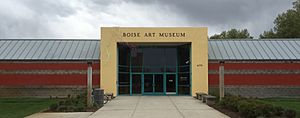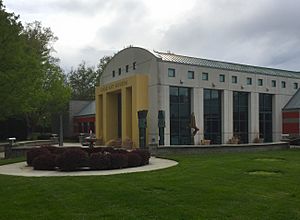Boise Art Museum facts for kids

Entrance of BAM in 2016
|
|
| Established | 1937 |
|---|---|
| Location | 670 Julia Davis Drive Boise, Idaho |
| Type | Art museum |
| Collection size | 3,500 works |
| Boise Art Museum | |
|---|---|
| Former names | Boise Gallery of Art |
| General information | |
| Architectural style | Art Deco, Egyptian Revival, Postmodern |
| Construction started | February 24th, 1934 |
| Completed | 1937 |
| Renovated | 1972, 1988, 1997 |
| Design and construction | |
| Architect | Tourtellotte & Hummel (1937); Trout Architects and Mark Mack (1988); CSHQA (1997) |
The Boise Art Museum (BAM) is a cool place to see art in Boise, Idaho. It's located at 670 Julia Davis Drive, right in Julia Davis Park. This park is home to many public museums and fun cultural spots.
BAM has a growing collection of art. You can see contemporary realism, which is art that looks very real. There are also modern and contemporary ceramics, which are art pieces made from clay. The museum also has the biggest public collection of works by James Charles Castle. He was a famous Idaho artist who made unique art and books. Besides its permanent collection, BAM often hosts exciting traveling art shows and special displays throughout the year.
The museum first opened in 1937 as the Boise Gallery of Art. It was created through a partnership between the Boise Art Association, the City of Boise, and the Federal Works Progress Administration. The goal was to give people in Boise a place to see local artists, traveling shows, and borrowed artworks. The original building had a special look, mixing Art Deco and Egyptian Revival styles.
The building was updated in 1972 and again in 1988. That's when its name changed to the Boise Art Museum. At this time, the museum started focusing more on building its own permanent art collection and offering educational programs. In 1997, the museum got even bigger. It added more office space, storage, a sculpture court, and art studios for learning.
Today, the Boise Art Museum is the only museum in Idaho that collects fine art and is approved by the AAM. It's a key place for fine arts in the Treasure Valley area.
Contents
Art Collection: A Journey Through Time
The Boise Art Museum has collected many amazing artworks over the years. Its collection has grown a lot, showing different styles and artists.
Early Art Acquisitions (1934–1988)
The Boise Art Association started collecting art even before the museum building was finished in 1934. The very first artwork they bought was a painting by Harvey Gregory Pruscheck for $100. Another early gift was the painting Mustard Field by Fanny Dike Burns. By 1955, the small collection included works from artists like Helen Aupperle, Reeves Ulher, and even Walt Disney.
In the 1960s, people became more interested in growing the collection. The museum hired its first professional staff. A big donation in 1963 from Robert V. Hansberger included six oil paintings. These paintings were by artists such as Flavin Gabral, Michael Frary, and Eric Sloane. In 1967, the museum got a unique sculpture called Silvertone 17 Inch Portable Television by Edward Kienholz. The museum's director at the time, Joseph Stewart, said this artwork made people think about how much time they spent watching TV.
By 1969, the Boise Junior League had given six artworks to the museum. These included Primaevus by Jimmie Faulkner and Age of Innocence by Alfred Kober. That same year, Louise Odencrantz from New York donated over 100 dolls from different cultures. These dolls were even allowed to be handled by children during an exhibition!
The museum kept looking for high-quality art in the 1970s and 80s. The art curator, Ric Collier, believed the collection should show the museum's past exhibits and its support for Idaho artists. In 1979, the Idaho Commission on the Arts gave the museum money to buy art by Idaho artists. They bought Last Black Triangle by Boyd Wright, plus works by David Wharton and Charles Crist. In 1980, the museum received donations from the American Academy of Arts and Letters. They also got four artworks from the family of artist Reginald Marsh.
Growing the Collection (Since 1988)
The Boise Art Museum really started building its permanent collection in 1988. Sandy Harthorn, the curator, helped the collection grow from 1,200 artworks in 1991 to 3,500 by the time she retired in 2015. She explained that changing the name from "Gallery" to "Museum" meant a bigger focus on collecting and keeping a permanent collection. The museum mainly collects 20th-century realism and ceramics from American, Northwest, and Idaho artists. However, the collection also includes art from across the United States, Europe, and East Asia. Many artworks have been donated by artists, galleries, and collectors.
In 2000, the museum received 23 works of contemporary realism from Peter and Eileen Norton. This was part of a huge donation of over 1,000 artworks given to 29 museums across the U.S. These artworks included pieces by famous artists like Robert Rauschenberg, Robert Arneson, and April Gornik. Most of these works were made in the 1980s and early 1990s. They fit well with the American realism collection already donated by Glenn C. Janss. This donation came after John Takehara gave 166 artworks by American, Australian, British, and Asian artists.
In 2002, Wilfred Davis Fletcher donated 117 artworks to the museum. This gift was valued at over $1 million! Most of these were modern abstract works. They were a great addition, complementing the museum's existing collection of realistic art.
Museum Architecture
The most recent addition to the museum happened in 1997-1998. The local architecture firm, CSHQA, managed this project. They added the unique sculpture court and sculpture garden to the back of the building. This expansion added 13,800 square feet, bringing the total size of the museum to 34,800 square feet.
Museum History
The Boise Art Association was started on October 8, 1931. More than 50 people attended the first meeting. They decided the group's purpose was to help people in Boise and Idaho appreciate fine and applied arts more. They also wanted to collect artworks, receive gifts, and create a suitable gallery to display art.
See also


